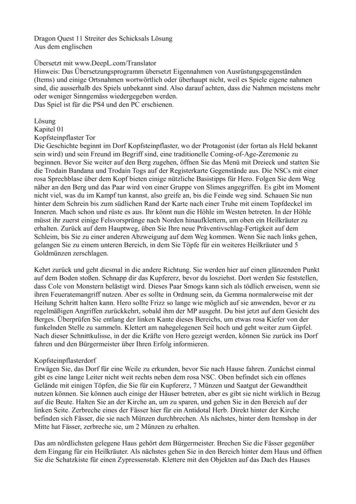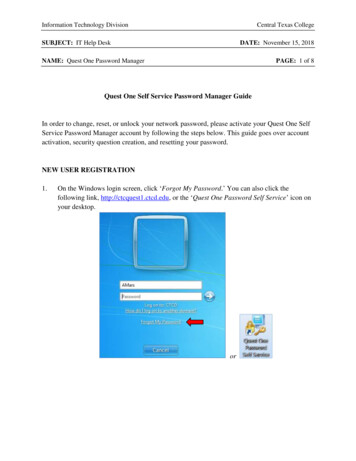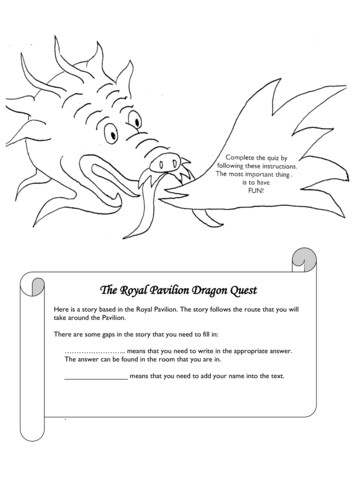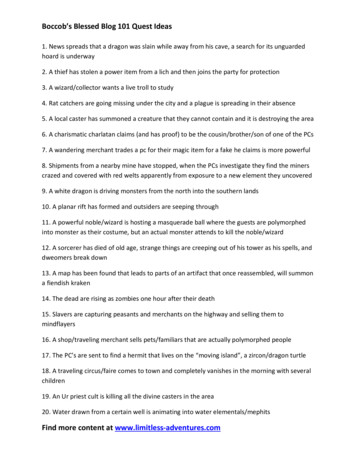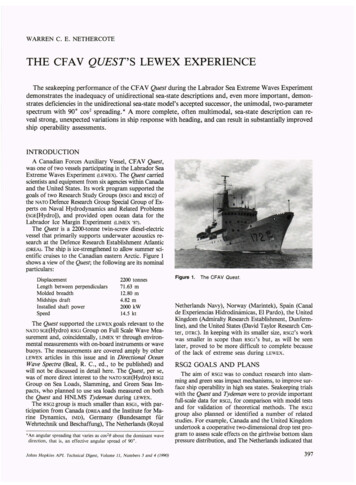
Transcription
WARREN C. E. NETHERCOTETHE CFAV QUEST'S LEWEX EXPERIENCEThe seakeeping performance of the CFA V Quest during the Labrador Sea Extreme Waves Experimentdemonstrates the inadequacy of unidirectional sea-state descriptions and, even more important, demonstrates deficiencies in the unidirectional sea-state model's accepted successor, the unimodal, two-parameterspectrum with 90 cos 2 spreading. * A more complete, often multimodal, sea-state description can reveal strong, unexpected variations in ship response with heading, and can result in substantially improvedship operability assessments.0INTRODUCTIONA Canadian Forces Auxiliary Vessel, CFAV Quest,was one of two vessels participating in the Labrador SeaExtreme Waves Experiment (LEWEX). The Quest carriedscientists and equipment from six agencies within Canadaand the United States. Its work program supported thegoals of two Research Study Groups (RSGI and RSG2) ofthe NATO Defence Research Group Special Group of Experts on Naval Hydrodynamics and Related Problems(SGE [Hydro]) , and provided open ocean data for theLabrador Ice Margin Experiment (LIMEX '87).The Quest is a 2200-tonne twin-screw diesel-electricvessel that primarily supports underwater acoustics research at the Defence Research Establishment Atlantic(DREA). The ship is ice-strengthened to allow summer scientific cruises to the Canadian eastern Arctic. Figure 1shows a view of the Quest; the following are its nominalparticulars:DisplacementLength between perpendicularsMolded breadthMidships draftInstalled shaft powerSpeed2200 tonnes71.63 m12.80 m4.82 m2000 kW14.5 ktThe Quest supported the LEWEX goals relevant to theNATO sGE(Hydro) RSGl Group on Full Scale Wave Measurement and, coincidentally, LIMEX '87 through environmental measurements with on-board instruments or wavebuoys. The measurements are covered amply by otherLEWEX articles in this issue and in Directional OceanWave Spectra (Beal, R. C., ed., to be published) andwill not be discussed in detail here. The Quest, per se,was of more direct interest to the NATO SGE(Hydro) RSG2Group on Sea Loads, Slamming, and Green Seas Impacts, who planned to use sea loads measured on boththe Quest and HNLMS Tydeman during LEWEX.The RSG2 group is much smaller than RSGl, with participation from Canada (DREA and the Institute for Marine Dynamics, IMD), Germany (Bundesampt furWehrtechnik und Beschaffung), The Netherlands (Royal*An angular spreading that varies as cos 2 (J about the dominant wavedirection, that is, an effective angular spread of 90 .fohns Hopkin s APL Technical Digest, Volume 11, Numbers 3 and 4 (1990)Figure 1.The CFAV Quest.Netherlands Navy), Norway (Marintek), Spain (Canalde Experiencias Hidrodimimicas, El Pardo), the UnitedKingdom (Admiralty Research Establishment, Dunfermline), and the United States (David Taylor Research Center, DTRC). In keeping with its smaller size, RSG2'S workwas smaller in scope than RSGl'S but, as will be seenlater, proved to be more difficult to complete becauseof the lack of extreme seas during LEWEX.RSG2 GOALS AND PLANSThe aim of RSG2 was to conduct research into slamming and green seas impact mechanisms, to improve surface ship operability in high sea states. Seakeeping trialswith the Quest and Tydeman were to provide importantfull-scale data for RSG2, for comparison with model testsand for validation of theoretical methods. The RSG2group also planned or identified a number of relatedstudies. For example, Canada and the United Kingdomundertook a cooperative two-dimensional drop test program to assess scale effects on the girth wise bottom slampressure distribution, and The Netherlands indicated that397
w.C. E. Nethercotethe Royal Netherlands Navy full-scale green seas loadingtrials might become available to the group.The RSG2 plan for the Quest and Tydeman wasstraightforward:1. Perform individual and side-by-side seakeeping trials with the Quest and Tydeman during LEWEX .2. Conduct model tests with the Quest, or perhapswith both ships, in scaled LEWEX directional seas inMarintek's facilities in Trondheim, Norway. (See the article by Kjeldsen, this issue.)3. Use the trials and model test results to validate theoretical methods used or under development by the RSG2members.INSTRUMENTATIONDuring LEWEX, the Quest carried or deployed the systems outlined in Table 1. The moored wavebuoys weredeployed in 2700 m of water. These deep-water mooringswere a high-risk element in LEWEX because they were"once-only" evolutions. The moorings had to be manufactured, before sailing, for a specified water depth, andthe design had only a limited margin against failure soas to reduce the cost of the lower parts of the moorings,which would not be recovered.The "drifting" wavebuoys typically were streamed towindward of the drifting ship in series on an approximately l()()()-m polypropylene tether, which produced noapparent interference with wavebuoy motions.The navigation radar photos experiment was an offshoot of the author's interest in deriving normalized directional wave spectra using navigational radar as a meansof reducing reliance on wavebuoys during seakeeping trials. All too often, when conditions are ideal for seakeeping trials, wavebuoys cannot be deployed from the ship.Given the expected LEWEX wave spectral database forvalidation, it seemed appropriate to examine the navigational radar technique; Nordco Limited was contractedto develop a photographic apparatus corresponding tothat used by Young et al. 1 to record radar sea-clutter information.A number of sets of radar sea-clutter photographs weretaken during LEWEX . Nordco subsequently developedanalysis techniques and software 2,3 so that the radartechnique could be assessed in the LEWEX comparisons. 4In ongoing contracted research, Nordco is investigatingthe possibility of scaling the radar-derived spectra to allowthe significant wave height to be determined.The current meter, an InterOcean S-4 electromagneticunit, also could measure salinity and depth. Its output,together with expendable bathythermograph records taken on station and while in transit between sites, wasprimarily for the benefit of LlMEX '87.The Quest's motions were measured using two shipmotion packages. The DREA'S own package used strapdown pitch, roll, and yaw gyros (both angle and rate)as well as a strap-down triaxial accelerometer. Additionalaccelerometers were placed at other locations on the ship.The Institute for Marine Dynamics, St. John's, Newfoundland (IMD) package measured similar parametersbut had a stabilized platform so that accelerations wouldbe measured relative to Earth-fixed, rather than shipfixed, axes.Ten 305-mm-diameter Metrox pressure transducers,installed in the starboard bow flare (Fig. 2), were of greatinterest to RSG2. Large-diameter pressure transducers en-Table 1. Instrumentation carried or deployed by the Quest during LEWEX.ParameterSystemSea stateSea stateWavec buoyEndeco buoySea stateSea stateEndeco buoyDelft buoyLocationMooredMooredand u larCurrentShipmotionsShipmotionsSea loadsSea loadsWavecrest buoyNavigation radarphotosInterOcean S-4"Strap-down"packageHumphrey stableplatformPressuretransducersStrain gaugingDriftingOn boardEndecomooringOn board--, . .IIWindlasscompartment- - r- pT fLIIIStoresDREA - -DIOn boardIMDBallasttankBow flareDREAHullDREAa Marine Environmental Data Service, Department of Fisheries andOceans, Ottawa.398/'IMDDREA IStoresI Upper deck/.( - - - - - - IDelft/DREA----F ; I -d-e - - - - - - - - - - --,DTRCDTRCSea stateSea stateForeperpendicu larDREA\() Water levelII IFigure 2. Starboard profile of the Quest and arrangement ofthe pressure transducers.f ohns Hopkins A PL Technical Digest, Volume 11, N umbers 3 and 4 (1990)
The CFAV Quest 's LEWEX Experiencesured that only distributed pressures of structural significance were measured. More common small-diameterpressure transducers often detect extreme, but very localized, pressures that are of little relevance to ship structure design.Strain gauges were also installed, both adjacent to oneof the pressure transducers and on the main-deck longitudinal girders ahead of and abaft the superstructure(Fig. 2). The bow-flare gauges were arranged to complement the pressure transducers, and the deck longitudinalgirder gauges assessed the bow-flare slamming-inducedlongitudinal bending.Waves Wavebuoys\\\\SHIP PERFORMANCE AND SEA LOADSLEWEX suffered from an excess of good weather;both the Tydeman and the Quest saw their worst weatherin transit to the trials area. The Quest steamed fromHalifax to St. John's in heavy quartering wind and sea,with freezing spray, and on the evening of 7 March 1987,while off the Laurentian Fan, an unexpectedly large wavegroup rolled the ship down to angles beyond the rangeof the bridge inclinometer (40 Inclinometers are notably inaccurate, so it is unfortunate that neither shipmotion package was operating at the time.The Tydeman's arrival in St. John's was delayed byadverse gales and heavy pack ice, so that the Quest leftfor the LEWEX site without having made a planned preLEWEX rendezvous with the Tydeman.On her two LEWEX sites, the Quest saw maximum significant wave heights, H s , of only 4.3 m and typicalsignificant wave heights of 2.5 to 3.5 m. Perhaps withthe exception of the 4.3-m sea state of 17 March, theseconditions were inadequate to provide the sea loads anticipated by RSG2 and required for full satisfaction of theRSG'S goals.The Quest's seakeeping trials were planned to concentrate on the measurement of bow-flare slamming pressures, using the ten large pressure transducers describedearlier. An unconventional seakeeping trial pattern wasselected in recognition of that goal. Rather than measuring responses at a full range of headings to the sea, afour-heading seakeeping pattern was selected (Fig. 3).Headings ranged from head to starboard beam seas, in30 steps (with head seas being 180 after the standardnaval architectural convention). This pattern also servedto make identification of "true" head seas less critical.Side-by-side seakeeping trials were conducted when theQuest and Tydeman were at the same site in LEWEX,with the Tydeman to starboard of the Quest so that videoand cine records could be made of the relative motionsat the Quest's bow.One of the most difficult on-site decisions during theLEWEX seakeeping trials was simply to determine, "Inwhat direction are head seas?" With multi modal seastates often being the norm, leftover swell frequently wasmore prominent than the new wind sea; for consistency, wind direction and wind sea direction were used toselect the first course to steer. On several occasions, thischoice clearly proved to be wrong, as pitch angles anddeck wetness were more severe on the supposed beamseas heading than the initial one in "head" seas. Figure 3.2.0The Quest's seakeeping pattern., - - - - , - ------ -----,-----,----,0).00,fohns Hopkins APL Technical Digest, Volume 11, Numbers 3 and 4 (1990).,Thoo ""March 15 "'------ . ----4180.5l . . . - l . . . -.L.- - - ' - .I.--.!12015090Ship heading to seas (deg)Figure 4. Variation of theoretical and trial pitch with ship head·ing. The theo uses a unimodal spectrum with 90 spreading.180Figure 4 illustrates this situation for the Quest by comparing the variation of pitch with heading with a prediction of the expected trend using SHIPM04,5 a typical"ship theory seakeeping computer program. The SHIPM04prediction was performed by using a Bretschneider twoparameter spectrum with a 90 cos 2 spreading function.The character of the trial results for 15 and 23 Marchdiffered markedly from the strip theory trend. A similar result might be expected for roll motions, but cleartrends were obscured by the Quest's roll-stabilizing tank.Pressure data show similar divergence from headingdependencies implied by an assumption of unimodal seastates. Selected pressure transducer data are shown inFigure 5, together with SHIPM04 predictions of trends forimmersions and pressures. (The theoretical pressure trendis, in fact, the square of the relative velocity, which isproportional to pressure.) Trends for other pressuretransducers also diverged from unimodal expectations,although some pressure transducer data were corruptedby amplifier overloading. A repeat bow-flare slammingtrial was carried out in higher sea states in March 1989to seek further data for RSG2.The LEWEX sea states were so low that little usefulstrain data were obtained, although that could also be0399
w.C. E. Nethercote 3010.0x 207.5:sa 6N Q). :; Q) Q) 10 .Q)e. Q)----- ----/'roe.!'.-----.-- . ---. . - - /(/)(/) 0March15172324 5Ci 200 E. 1520Figure 6. Experimental and finite·element-strain time seriesfor a bow-flare plating strain gaug (see Fig. 2).'010010Time (s)Ci .DE:::JZNAVAL ARCHITECTURAL IMPLICATIONSo180Head150120Bow90Before examining the naval architectural consequencesof the Quest's LEWEX experience in any detail, it is worthrecalling the results of an earlier Quest ship motions trial,when the Quest was operating with her roll stabilizingtank empty, so that roll performance can be includedin an assessment of short-crested sea effects.During the earlier trial, a passing low-pressure systembrought 20- to 40-kt winds, which veered from southsoutheast through to west-southwest in 32 hours and generated 5- to 7-m sea states. The steadily veering windsensured that there was always a very apparent shortcrested character to the sea. Table 2 summarizes somesea states and ship motions during the storm. Sea statewas both measured by wavebuoys and hindcast using theOcean Data Gathering Program (ODGP) wave model. 8Large roll angles in nominal head seas (experimentsD and E) are particularly noticeable in Table 2. If wecombine this information with experiments Band C,which were consecutive beam and bow seas runs, it isagain apparent that short-crested seas produce ship motions that do not vary with heading in the manner conventionally assumed. What are the consequences?BeamShip heading to seas (deg)Figure 5. Immersion frequency and pressure for a selectedpressure transducer, together with theoretical predictions oftrends for immersion and the square of relative velocity (whichis proportional to pressure) for a unimodal spectrum with 90 spreading.attributed to the use of the Quest itself. A short, deep,ice-strengthened ship cannot be expected to exhibit highmain-girder strains in other than exceptional conditions.On a positive note, the bow-flare strain gauge datawere used in a finite-element validating study. Pegg etal. 6 applied measured-pressure time series to predict dynamic strains in the bow-flare region using the Vibration and Strength Analysis Program,7 a finite-elementcode developed by Martec Limited under contract fromDREA. The measured strains were used to validate thefinite-element predictions for the same points. Figure 6compares measured and flnite-element -predicted straintime histories.Table 2.Summary of Quest motions from an earlier trial.Rrns motionsHsExperimentABCDESpeed(kt)Headingto sea:: 0:: 5:: 5:: 2:: 2BeamBeamBowHeadHeadOooP 55.07.06.51.931.882.303.062.617.94 a5.065.034.804.06Center 660.057a Roll is largest in experiment A because the sea-state modal period was near roll resonance.400Johns Hopkin s APL Technical Digest, Volume 11 , Numbers 3 and 4 (1990)
The CFA V Quest's LEWEX ExperienceMany, if not most, ship seakeeping operability criteriaare based on motions. For example, let us suppose thata particular shipboard operation must be curtailed when0the roll angle exceeds 4 rms. Roll motions are lightlydamped and thus are very sensitive to resonance. If along-crested sea state is assumed, theory predicts thatroll-curtailed operations may be restored through a simple change of heading. Even with a more realistic seastate model using 90 cos 2 spreading, a heading changecan often restore operability, albeit over a smaller rangeof headings. If our sea-state model is extended to a typical LEWEX swell-corrupted directional spectrum, theheading sensitivity of motion response may be significantly modified. At times, operability may be curtailedat nearly all headings after only a small further increasein sea state. Figure 7 illustrates the effect of sea-statemodeling on a 5200-tonne frigate steaming at 20 kt insea state 7, with a 6-m significant wave height, and subject to a 4 rms roll angle limit on a shipboard operation.An ad hoc group of five sea-state models was chosenfor this example:1. A Bretschneider spectrum, with a 12.4-s modalperiod and no spreading.2. Same as (1), but with a 90 cos 2 spreadingfunction.3. With (2) as the primary sea, and with (1) as thesecondary, at 45 to the primary direction and with aprimary-to-secondary energy ratio of 2: 1, to representconditions during the nearby passage of a low-pressuresystem.4. Same as (3) , but with the secondary sea 90 fromthe primary direction and a primary-to-secondary energy ratio of 3: 1, to represent the effects of a distant weather system,5. Same as (3), but with the secondary sea 135 fromthe primary direction and a primary-to-secondary energy ratio of 4: 1, again to represent the effects of a distant weather system.In reality, these models might be more representativeif the total energy in models (4) and (5) were increasedover that of the 6-m sea state by the amount in the secondary sea but the significant wave height were held constant to reduce the number of variables. Table 3 summarizes the results as a range of inoperable headings forboth 4 and 3 roll criteria and as range of rms roll angle from best to worst heading. The 3 criterion was added because operability limits are rarely "hard" in practice.This is particularly relevant to model 4, where either asmall increase in wave height or a small decrease in theacceptability criterion would significantly reduce operability. The range of roll angle between best and worstheading is so small for model 4 that degradation of operability will be very rapid with only a small sea-state increase, with little opportunity for compensatory headingchange. This insensitivity of response to heading is reminiscent of much of the Quest's LEWEX experience.Similar examples could be given for other criteria, using the LEWEX experience. For example, pressure transducer immersions could be correlated with relativemotion records to draw conclusions about bottom slamming or deck wetness.0Inoperable headings .4OJQ) Q)0,c('Ije(f)Ea:20270180090BeamHeadBeamShip heading to primary sea (deg)0Figure 7. Operability of a 5200-tonne frigate subject to a 4rms roll limitation on shipboard operations. See the text for thedefinition of a sea-state model.00Table 3.Operability of a 5200-tonne frigate in 6-m seas.Inoperable headingrange (deg)0Sea-statemodel4 criterion3 criterion2345881641424313316825823131625400000John s Hopkins APL Technical Digest, Volume 11, Numbers 3 and 4 (1990)00Roll range(deg)Best -worst7 03.13.52.03.4What are the broader implications of LEWEX for naval architecture? For the most part, they are related tooperability. Naval vessels are now designed with seakeeping in mind, and linear, two-dimensional theory shipmotion-prediction codes frequently are used to rank orevaluate the candidate design's lifetime or the mission'soperability in locations of interest. Routinely, unimo0dal multidirectional seas are used, with 90 as the accepted spreading angle. The example above, togetherwith the Quest's own experience, suggests that applyingspreading to unimodal spectra is not enough; the common occurrence of multimodal sea states must be recognized. This is a painful conclusion.When Bales et al. 9 reported the results of hindcastingfor NATO operational areas, they firmly established theuse of short-crested sea states, in part, at least, becausethey reported results in a format convenient for existingfrequency-domain seakeeping codes. If multimodal seastates are important to naval architecture, then the hindcasting results must be used more directly. This is considerably more onerous than simply assuming a 90spreading angle and using a joint probability table forsignificant wave height and modal period.0401
w.C. E. NethercoteAlthough feasible, simply simulating seakeeping performance and operability using an archived hindcastspectral database cannot be considered practical. To encourage the use of multimodal, multidirectional spectra,it would be better to employ a multiparameter spectrum,together with associated probability distributions forspectral parameters, to generalize an operational areahind cast for frequency-domain seakeeping calculations.Hogben and Cobb 10 have reported a parametric directional wave spectral model that, in principle, satisfiesthese goals. luszko Scientific Services, under contractto DREA, is developing this model further, to address bimodal spectral modeling in Canadian operational areas.CONCLUSIONThe good weather conditions that predominated during LEWEX prevented the achievement of goals dependent on high sea states; however, the LEWEX pressuretransducer and strain data were valuable for at least tworeasons. First, when compared with relative motionpredictions, pressure transducer data gave further evidence of the inability of a unimodal sea-state model todescribe the sensitivity of ship response to heading. Second, the bow-flare pressure and strain data provided arare opportunity to validate the ability of a finite-elementcode to model stresses in a complex, three-dimensionalstructure under dynamic loading.The LEWEX experience confIrms that multimodal spectra must be regarded as a common occurrence at sea. Asa result, the relatively recent acceptance of multidirectionalunimodal spectra for routine seakeeping evaluation in thedesign process offers insufficient improvement over theunrealistic unidirectional, unimodal sea-state model.Results of two Quest seakeeping trials, one in light-tomoderate seas (LEWEX) and an earlier one in heavier seas,demonstrate that unimodal sea-state models, even withspreading, fail to model properly the relationship of shipmotions and heading. A simple operability example fora destroyer gives similar results.The use of unimodal short-crested spectra, althoughan advance over unidirectional spectra, is insufficient topredict ship operational capability. The multimodal nature of a significant proportion of open-ocean spectramust be recognized and modeled if operational studiesare to be realistic. Hindcasts offer a way to define multimodal seas, but the practical implementation of the information depends on the reformulation of hindcasts asmultiparameter spectral models, with associated jointprobability tables, suitable for use in frequency-domainseakeeping codes.402REFERENCESI. R., Rosenthal, W., and Ziemer, F., "A Three-Dimensional Analysisof Marine Radar Images for the Determination of Ocean Wave Directionalityand Surface Currents," J. Geophys. Res. 90, 1049-1059 (1985).2Nickerson, W., and Clarke, C. A., Measuring Ocean Wave Spectra from Marine Radar Sea Clutter, Nordco Limited, Defence Research Establishment Atlantic Contractor Report CRl88/ 423 (1988).3Clarke, C. A., and ickerson, W. , Measuring Ocean Wave Spectra from Marine Radar Sea Clutter-Software User's Manual, Nordco Limited, DefenceResearch Establishment Atlantic Contractor Report CR/ 88/ 424 (1988).4Ziemer, F., "Directional Spectra from Shipboard Navigation Radar duringLEWEX," in Directional Ocean Wa ve Spectra, Beal, R. c., ed., The JohnsHopkins University Press, Baltimore (in press, 1991).5Graham, R., and Trudelle, c., SHIPM04: An Updated User's Manual forthe SHIPMO Computer Program Incorporating an Extended HydrostaticsCapability and an Improved Viscous Roll Damping Model, Defence ResearchEstablishment Atlantic Technical Communication 87/ 304 (1987).6Pegg, N. G., Vernon, T . A., Wegner, L. , and ethercote, W. C. E., "FiniteElement Prediction of Measured Bow Hare Plate Stresses under Dynamic WaveLoading," Trans. R . Inst. Nav. Architects 131, 135-143 (1989).7Martec Limited, Defence Research Establishment Atlantic, Vibration andStrength Analysis Program (VAST), Version 04, Contractor Report 86/ 429(1986).8MacLaren Plansearch Limited and Oceanweather, Inc., Development and Evaluation of a Wave Climate Data Base for the East Coast of Canada, ContractReport for Department of Fisheries and Oceans, Ottawa (1988).9Bales, S. L., Lee, W . T ., and Voelker, J. M., Standardized Wave and WindEn vironments for NA TO Operational Areas, David Taylor Naval Ship R&DCenter SPD-0919-01 (1981 ).10 Hogben , ., and Cobb, F. c., "Parametric Modeling of Directional WaveSpectra," in Proc. Eighteenth Annual Offshore Technology Conj, Vol. I(1986).1Young,ACKNOWLEDGMENTS:Ross W. Graham provided valuable discussionsbefore and after LEWEX and most recently through his membership in the Canadian East Coast Waves Project Group. Walter Ellis analyzed the Quest LEWEXtrials results. Bert Hartling of the Bedford Institute of Oceanography was responsible for the design and manufacture of the deep-water wave buoy moorings . Ofcour e, special attention must be given to the cooperation and support of Captain Bill Whyte, the officers, and crew of the Quest , as well as the scientific staffon board during LEWEX.THE AUTHORWARREN C. E. NETHERCOTEis the head of the Hydronautics Section at the Defence Research Establishment Atlantic, Dartmouth, NovaScotia, and was chairman of NATOSGE(HydrO), RSG2.fohns Hopkins APL Technical Digest, Volume 11, Numbers 3 and 4 (1990)
WARREN C. E. NETHERCOTE THE CFAV QUEST'S LEWEX EXPERIENCE The seakeeping performance of the CF A V Quest during the Labrador Sea Extreme Waves Experiment
